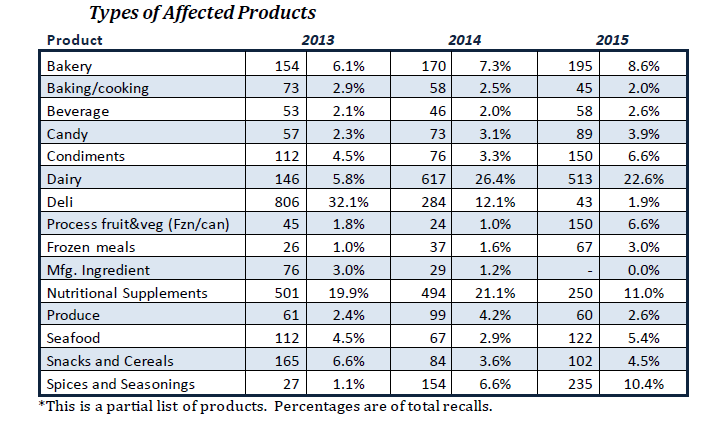Blue Bell recalled hundreds of ice cream products after being linked to an outbreak of listeriosis which sickened 10 people from four states and three deaths.
Another sizeable recall involving potential Listeria contamination of about one hundred ice cream products made by Jeni's Splendid Ice Creams occurred last year.
Another case involved 34 processed cheese products recalled by Kraft due to the plastic film remaining attached to the cheese slice.
The report covers all of 2015, compared with the one we covered earlier, which covered recalls through to September of last year.
SAGE Food Safety Consultants provides guidance, crisis communications management and training on food safety to businesses in the industry.
Nutritional supplements ranked second for the third year in a row with manufacturing violations causing almost 60% of recalls.
Gale Prince, SAGE president, said the Food Safety Modernization Act (FSMA), and the final rules which take effect from this year, may help address problems by requiring more proactive measures to prevent recalls.
"Food companies must have a total food safety plan in place, along with a recall procedure, and they must aggressively monitor their supply sources, production, packaging and shipping procedures to limit the chances of contamination. If they don't, they could face serious regulatory action."
FDA and USDA recall stats
In the US, recalls by the Food and Drug Administration (FDA) declined slightly again, continuing a pattern from 2012, although meat recalls by the US Department of Agriculture (USDA) reached an all-time high, increasing by almost 60% from the previous year.
However, there was an increase in FDA product recalls due to Listeria, which accounted for about three-fourths of total microbiological recalls over the last three years.
“Although recalls involving Listeria have slightly declined the last couple of years, there are still numerous problems within facilities pertaining to the plant environment, design of equipment, and the ability to properly clean and sanitize between runs,” said the report.

Recalls due to foreign material contamination decreased in 2014 but were back up again in 2015.
Metal fragments in the finished product are the most common reason for product contamination followed by plastic pieces.
Listeria monocytogenes has come down considerably as the cause for USDA recalls. Salmonella remained steady the last two years and declined last year. E. coli recalls only increased slightly in 2015 after a significant drop last year, said the report.
Prince said the data in the report can provide valuable information for companies looking for ways to reduce contamination vulnerabilities in food production.
"Listeria, for example, is very difficult to find in a plant setting. The recall data should provide added impetus for manufacturers to double their efforts to locate places where Listeria might be present, and remove the threat."
Canadian and European recalls
Canadian and European food recalls decreased modestly from 2014 levels.
CFIA recalls were down over 30% compared to 2014. There were 444 recall events in Canada in 2015 that caused 1,599 products to be recalled.
After a large spike in 2014, the frequency of recalls due to undeclared allergens went down in 2015; although they were still the number one cause.
Salmonella accounted for almost 50% of products recalled for micro reasons while Listeria contamination affected just 20%.
Extraneous material that generated recalls mainly included metal, glass, plastic, and insects and also slightly increased last year.
While US and Canadian recalls for E. coli have declined, those in Europe have remained steady.
RASFF recalls and withdrawals reached their highest point in 2014 but last year recalls increased while withdrawals decreased.
Toxins are the leading cause when it comes to chemical issues. Mycotoxins, such as aflatoxin and vomitoxin, in grain foods account for a quarter of these type of recalls.
Withdrawals and recalls on seafood products have been the number one category for the last three years.
Allergen issue
Undeclared allergens continued to be a major - and growing - factor. Often this is due to cross contamination during manufacturing, said SAGE.
Peanut contaminated cumin that was used in a large number of products accounted for a surge of recalls of FDA and USDA products at the end of 2014 and into 2015. Although Canada was affected by this in 2014, it appeared to be over by 2015.
Products with undeclared milk remain as one of the top reasons for recalls and withdrawals. Recalls due to chemical contamination of seafood, grain, and produce continue to be seen in Europe.
“Another cause for an increase in allergen related recalls is due to a product with allergens being put into the wrong or outdated packaging. For this reason, many food making facilities are investing in packaging control software in order to reduce human error that has occurred in the past,” said the report.
